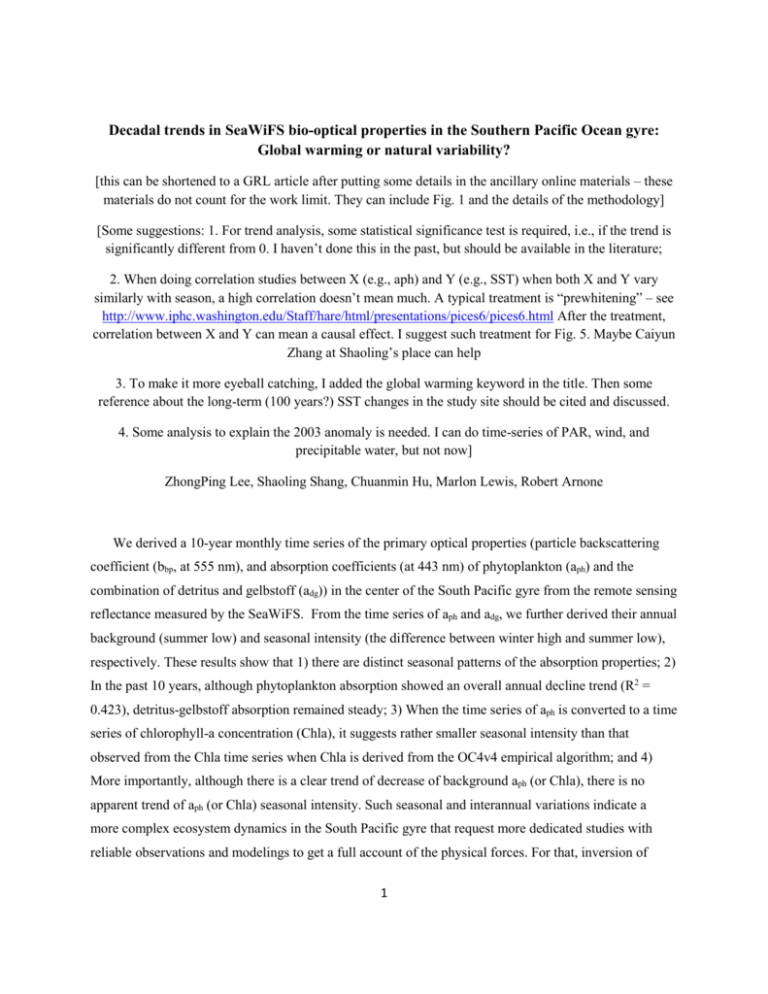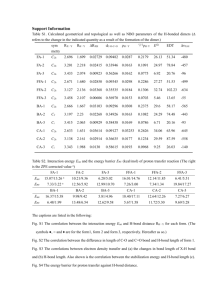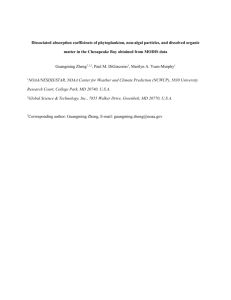Decadal trends in D ynamics of water`s SeaWiFS bio
advertisement

Decadal trends in SeaWiFS bio-optical properties in the Southern Pacific Ocean gyre:
Global warming or natural variability?
[this can be shortened to a GRL article after putting some details in the ancillary online materials – these
materials do not count for the work limit. They can include Fig. 1 and the details of the methodology]
[Some suggestions: 1. For trend analysis, some statistical significance test is required, i.e., if the trend is
significantly different from 0. I haven’t done this in the past, but should be available in the literature;
2. When doing correlation studies between X (e.g., aph) and Y (e.g., SST) when both X and Y vary
similarly with season, a high correlation doesn’t mean much. A typical treatment is “prewhitening” – see
http://www.iphc.washington.edu/Staff/hare/html/presentations/pices6/pices6.html After the treatment,
correlation between X and Y can mean a causal effect. I suggest such treatment for Fig. 5. Maybe Caiyun
Zhang at Shaoling’s place can help
3. To make it more eyeball catching, I added the global warming keyword in the title. Then some
reference about the long-term (100 years?) SST changes in the study site should be cited and discussed.
4. Some analysis to explain the 2003 anomaly is needed. I can do time-series of PAR, wind, and
precipitable water, but not now]
ZhongPing Lee, Shaoling Shang, Chuanmin Hu, Marlon Lewis, Robert Arnone
We derived a 10-year monthly time series of the primary optical properties (particle backscattering
coefficient (bbp, at 555 nm), and absorption coefficients (at 443 nm) of phytoplankton (aph) and the
combination of detritus and gelbstoff (adg)) in the center of the South Pacific gyre from the remote sensing
reflectance measured by the SeaWiFS. From the time series of aph and adg, we further derived their annual
background (summer low) and seasonal intensity (the difference between winter high and summer low),
respectively. These results show that 1) there are distinct seasonal patterns of the absorption properties; 2)
In the past 10 years, although phytoplankton absorption showed an overall annual decline trend (R2 =
0.423), detritus-gelbstoff absorption remained steady; 3) When the time series of aph is converted to a time
series of chlorophyll-a concentration (Chla), it suggests rather smaller seasonal intensity than that
observed from the Chla time series when Chla is derived from the OC4v4 empirical algorithm; and 4)
More importantly, although there is a clear trend of decrease of background aph (or Chla), there is no
apparent trend of aph (or Chla) seasonal intensity. Such seasonal and interannual variations indicate a
more complex ecosystem dynamics in the South Pacific gyre that request more dedicated studies with
reliable observations and modelings to get a full account of the physical forces. For that, inversion of
1
ocean color with semi-analytical algorithms that separate the optical contributions of phytoplankton and
gelbstoff is found important, even for this hyper-oligotrophic water.
Keywords: ecosystem, ocean color remote sensing, semi-analytical algorithm, gyre, phytoplankton,
gelbstoff
2
1. Introduction
Subtropical gyres are not only important for studies of ocean biogeochemistry and global carbon
cycle {Behrenfeld, 2006 #785}{McClain, 2004 #1025}, they are also important for detection of
anthropogenic climate change {Barnett, 2001 #1026}. Recent studies based on concentration of
chlorophyll-a (Chla) that are derived from satellite ocean color measurements have shown that either Chla
in the sub-trophic gyres is showing a decline trend {Gregg, 2005 #1027} or the areas of low Chla gyres
are expanding {McClain, 2004 #1025}{Polovina, 2008 #1024}. These studies implied a reduced growth
of phytoplankton in surface waters of the gyres in the past decade, speculated that it could be a result of
enhanced surface-water stratification {Gregg, 2005 #1027}{Polovina, 2008 #1024}. When analyzing the
existing satellite observations, however, these studies used Chla that were derived empirically via the
blue-green ratio, where the impacts of gelbstoff (or colored dissolved organic matter) were not removed.
Also, the studies generally focused on the trend of annual mean, where no trend was given about the
annual seasonal bloom. Note that the annual low provides a general information about the background
biogechemical status of the water, while the annual bloom (or annual intensity, which is the difference
between the annual high and low) depicts more about a response due to intensified physical forces.
Clearly, it is more informative to have separate analysis about the background and the seasonal intensity.
In this study, in order to get more detailed description about the dynamics of phytoplankton and
gelbstoff in the south Pacific gyre, and to provide new clue about the ecosystem response of oceanic
waters to climate change, we derived 10-year monthly time series of phytoplankton absorption (and later
its inferred Chla) and gelbstoff absorption coefficient from the measurement of SeaWiFS. In particular,
the semi-analytical algorithm used for satellite data processing was first evaluated with in situ
measurements made in the south Pacific gyre. From the time series, the trend of background and seasonal
intensity of the properties were statistically analyzed, respectively, and new insights of the dynamics of
biogeochemical properties in the south Pacific gyre are presented.
2. Data and method
2.1 In situ data
Hyperspectral (350 – 800 nm with 2 nm resolution) remote sensing reflectance (Rrs, ratio of waterleaving radiance to downwelling irradiance above sea surface) of five stations (STB4,5,8 and GYR4 and
5 that listed in Table 1 of Morel et al {, 2007 #817}) in the South Pacific gyre was measured by a vertical
profiler HyperPro (Satlantic, Inc.) in November 2004. Concurrent IOP data (absorption coefficients of the
3
total (a) and particulates (ap) at 420 nm) of these stations are from Table 1 of Morel et al {, 2007 #817}.
Absorption coefficient of yellow substance or gelbstoff (ag) at 420 nm is estimated from the presented
ag(310) value, with a spectral slope as 0.0203 nm-1 (for the wavelength range of 300-500 nm) reported in
the same article. No particle backscattering coefficients (bbp) are listed, but could be referred from Huot et
al {, 2008 #985} and Twardoski et al {, 2007 #1028} that bbp(550 nm) was in a range of 0.00015 –
0.00035 m-1 based on the listed Chla values. Although the five stations were not exactly at the same site
for trend studies from satellite measurements (see below), but their location in the gyres and their nature
of optical properties are ideal for evaluating performance of semi-analytical algorithms at such extreme
conditions.
2.2 Satellite data
The research site is a small box (23-28 S, 130-140 W) in the south Pacific gyre (see Fig.1), which is
approximately at the center of this gyre with spatial distribution of optical properties near uniform
{McClain, 2004 #1025}. For all pixels in this box, monthly binned – 9km resolution SeaWiFS
normalized water-leaving radiance (nLw, after reprocessing 5.2) at 412, 443, 490, 510, 555, and 670 nm
were downloaded from the OceanColor web Portal (http://oceancolor.gsfc.nasa.gov/) that is operated by
the Ocean Biology Processing Group supported by NASA. Further, in order to reduce impacts of random
errors on the inverted products, for each band the spatially averaged nLw within the box was used to
represent the water-leaving radiance of the study site of a month. The multiband nLw were then converted
to multi-band remote sensing reflectance (Rrs) by ratio nLw to extraterrestrial solar irradiance (F0), which
was also obtained from the OBPG.
SeaWiFS Rrs(670) calculated from the directly downloaded nLw were around 0.00026 sr-1, which are
considerably higher than that from MODIS for such clear waters {Franz, 2009 #1034}. As Rrs(670) is in
general between 0.00005 and 0.00016 sr-1 for bbp(670) between 0 and 0.001 m-1 (note that bbp(532) is ~
0.0002 m-1 for such super clearer waters {Twardowski, 2007 #1028} ) based on Hydrolight simulations,
these high values suggest a bias (over estimation) of SeaWiFS Rrs (also see Franz {, 2009 #1034}) for
these waters. To be more consistent with theoretical predictions, we therefore adjusted the SeaWiFS Rrs
by subtracting off 0.000175 sr-1 for all bands, i.e. effectively got an averaged Rrs(670) as 0.0001 m-1 for
such waters. This adjustment caused ~30% reduction in the derived bbp(555), and ~10% reduction in the
total absorption at 443 nm, which further translated to ~15% and ~5% reduction to the derived aph(443)
and adg(443), respectively. No impacts were found, however, to the patterns of seasonal and interannual
variations of the retrieved IOPs.
4
2.3 Inversion method
Previous studies {McClain, 2004 #1025}{Gregg, 2005 #1027}{Polovina, 2008 #1024} regarding the
oceanic gyres were based on the empirically derived chlorophyll concentration {SeaWiFS, 2000 #338}
from the observation of ocean color. Such empirical algorithms, however, does not separate the optical
contributions of gelbstoff from that of phytoplankton pigments, consequently it may view a signal of
gelbstoff as that of phytoplankton. To delineate the phytoplankton property with higher fidelity, we used a
semi-analytical algorithm {Lee, 2002 #195} to derive the absorption coefficients (at 443 nm) of
phytoplankton (aph) and the combination of detritus and gelbstoff (adg), and particle backscattering
coefficient (bbp, at 555 nm) of the study site from Rrs. And the performance of this algorithm was first
evaluated with in situ measurements made in the South Pacific gyre.
The algorithm for Rrs inversion is the quasi-analytical algorithm (QAA) {Lee, 2002 #195}{Lee, 2007
#732}. Waters in the gyres are quite special that molecular scattering makes the primary contribution to
the remotely collected signal in the blue-green wavelengths, and consequently the effects of the molecular
scattering phase function need to be well accounted {Morel, 1991 #127}{Sathyendranath, 1997
#278}{Lee, 2004 #252}. We therefore used a modified analytical function for Rrs {Lee, 2009 #1035}
based on the model of Lee et al {, 2004 #252} that explicitly separates the phase-function effects of
molecular and particle scatterings:
b ( ) bbp ( )
b ( ) bbw ( ) p
Rrs ( , ) G0w () G1w () bw
G0 () G1p () bp
,
( ) ( )
( ) ( )
(1)
with κ = a + bb. Values of the model parameters ( G0w (), G1w () , G0p (), and G1p () ) for various Sun
angles and viewing geometry have been developed based on Hydrolight simulations {Lee, 2009 #1035}.
For normalized water-leaving radiance, the G parameters are (0.059, 0.012, 0.053, 0.128).
In the inversion process, the backscattering and absorption coefficients of pure water are based on
Zhang et al {, 2009 #1029} and Pope and Fry {, 1997 #200}, respectively. Further, when decomposing
total absorption to contributions of phytoplankton and detritus/gelbstoff {Lee, 2002 #195}, the ratio of
aph(412)/aph(443) = 0.742 was used for such low phytoplankton waters [Dr. Annick Bricaud , personal
communication]; and the ratio of adg(412)/adg(443) = 1.568 was used, which is calculated with a spectral
slope of 0.015 nm-1 for spectral adg.
5
3. Results and discussion
3.1 In situ data
We used the published data {Morel, 2007 #817} to evaluate the inversion results. Figure 2 compares
Rrs-derived a(420), aph(420), and adg(420) with those presented in Table 1 of Morel et al {, 2007 #817},
respectively. As described in detail there, the optical values are extremely low for this oligotrophic water
in November (only a couple of months after the phytoplankton bloom {McClain, 2004 #1025}), with
a(420) in a range of 0.006 – 0.012 m-1, aph(420) between 0.0019 and 0.0041 m-1, and adg(420) between
0.0012 and 0.0032 m-1. Note that the published data are ap (for particles collected on filter pad) and ag (for
gelbstoff). Since the contribution of detritus is small for such waters {Siegel, 2002 #525}{Morel, 2007
#817}, it is appropriate to compare aph with ap and adg with ag, respectively. The Root-Mean-SquareDifference in linear scale (RMSD) between Rrs-derived and published data are ~0.0007 m-1 for a(420),
and ~0.0005 m-1 for both aph(420) and adg(420). On relative scales, the average relative differences for the
three properties are 8.8%, 18.0%, and 27.5%, respectively. These results confirm that Rrs-derived
properties are consistent with that determined independently from other means {Morel, 2007 #817}, and
prove the inversion algorithm can derive highly reliable absorption coefficients from Rrs for such
extremely clear waters.
The Rrs-derived “particle” backscattering coefficient at 556 nm (bbp(556)) are around 0.0007 m-1 for
the five stations, which are significantly higher (by ~0.0004 m-1 or 2-3 times) than those determined from
in situ instrumentations for those stations {Huot, 2008 #985}{Twardowski, 2007 #1028}. It is not clear
yet what could be the primary factor for this discrepancy. Some factors to be considered include particle
scattering phase function {Mobley, 2002 #241}, bubbles {Zhang, 1998 #222}, and wavefocusing effects
{Zaneveld, 2001 #454}, as at present the remotely derived “particle” backscattering coefficient is an
ensemble of all scattering phenomena other than molecule scattering; while in situ measurements will not
have the wavefocusing effects.
3.2 Satellite data
Apply the above validated algorithm to the time series of SeaWiFS Rrs, 10-years monthly aph(443),
adg(443), and bbp(555) of the study site were adequately derived (see Figure 3). From the monthly time
series of aph and adg, their annual background (i.e. assumed no seasonal disturbance) and primary seasonal
intensity are further derived and presented (see Fig. 4). The background is defined as the minimum during
summer (December-February), while the primary seasonal intensity (I) is defined as the difference
6
between the peak in Austral winter (June-August) and the trough during previous summer of a interested
property:
I Peak(in winter) Trough(in previous summer) .
(2)
For instance, the primary seasonal intensity of aph in the year 2000 is the result of aph at July 2000
subtracting aph at December 1999. The occasional secondary seasonal variations (sometimes happened
around March) are not evaluated here. To highlight such observations, empirical dynamic functions were
derived for aph and adg and are presented in Fig. 4. For aph, the dynamic function for aph is expressed as
{Winn, 1995 #1036}
a ph ( M ) 0.0011sin( 0.52 M 1.7) (0.0043 0.000009 M ) ,
(3)
with M = 1 for Jan 1998 and count consecutively. For adg, it is expressed as
adg ( M ) 0.0021 exp(
( M 7.3)2
) 0.0004 ,
4.41
(4)
with M = 1 for Jan 1998 and 12 for Dec 1998 and repeating the cycle for each year.
From these time series of optical properties, following valuable and important findings or messages
could be summarized:
Consistent with earlier studies that focused on chlorophyll concentration {McClain, 2004 #1025} or
the absorption of detritus and gelbstoff {Siegel, 2002 #525}, both aph and adg show clear seasonal
variations. But aph peaks roughly between June and July (M = 6.7) for each year for this location, which is
ahead of the adg peak (M = 7.3) by about half month, consistent with that observed by Hu et al {, 2006
#588} in the North Atlantic.
The background absorption of aph is significantly higher (~8 fold) than that of adg, but the seasonal
intensity of aph is about the same as that of adg (0.0022 vs 0.0021 m-1). Separately, when aph and adg are
contrasted with an SST time series (from AVHRR) of the same site (Fig.5), strong negative correlation is
found between adg and SST (R2 = 0.629), but not between aph and SST (R2 = 0.106). These results clearly
demonstrate that at this location the adg is regulated by phytoplankton degradation as well as by solar
photobleaching {Del Vecchio, 2002 #1033}{Nelson, 2002 #551}. At the same time, the reduction of UV
radiation in the Austral winter could have been significantly favorable for phytoplankton to grow {Cullen,
1994 #1037}.
7
The Rrs-derived bbp(555) are around 0.0007 m-1 (see Fig.3), consistent with that derived from in situ
Rrs measured in the South Pacific gyre. Unlike those of aph and adg, however, no apparent seasonal pattern
is observed for this SeaWiFS-derived bbp. A preliminary study found that such a feature-less pattern might
be due to the 10-bit digital dynamics of the SeaWiFS sensors, which might not be sensitive enough to
measure the subtle variability of Rrs at 555 nm {Hu, 2000 #986} for such waters.
No apparent interannual trend is found about the seasonal intensity of aph (see Fig.4), similar as that for
both the background and the seasonal intensity of adg for the 10-year time window. McClain et al {, 2004
#1025} suggested that the winter phytoplankton bloom is primarily a reflection of phytoplankton’s
adaptation to low light {Winn, 1995 #1036}, [why adaptation to low light leads to higher growth rate than
under high light?] not a result of enhanced vertical mixing that usually provides more nutrients, as the
depth of nutrient max at this location is still significantly deeper than the mix-layer depth (~250 m vs
~100 m). This is consistent with the above observation of low correlation between aph and SST. The
nutrients to support such blooms are considered coming from surface currents {McClain et al, 2004
#1025}. [do they have evidence or just speculation?] However, because of low temporal data of nutrients
(only seasonal), [so, seasonal nutrient data are available? Then they should be able to explain the seasonal
changes] it is not clear yet if this mechanism can fully account for these annual blooms. More detailed
data that have monthly vertical profiles of nutrients would greatly help to understand the mechanism of
this annual bloom.
Although the trend in seasonal intensity is weak (R2 = 0.097) for the ten year period, there is a stronger
decrease trend (R2=0.239) of the background aph in the past decade (see Fig.4). Because there is no
apparent trend in the seasonal aph intensities, it is puzzling about the physical forces that are responsible
for the decline of background phytoplankton. Earlier studies {Gregg, 2005 #1027}{Polovina, 2008
#1024} speculated that this reduction is a biological response to increased water temperature
(consequently enhanced stratification and reduced nutrient supply from vertical mixing). If nutrients for
phytoplankton in the gyres are mainly from lateral transportation {McClain et al, 2004 #1025}, then it is
less likely that the reduction of phytoplankton in surface waters is resulted from enhanced stratification.
Also, such statistical values are very sensitive to the time window. For instance, if we focus on the years
of 2000 – 2007 (8 years), aph background actually revealed no trend at all (R2 = 0.004), further suggesting
limited relationship between phytoplankton dynamics with water temperature. More studies with longterm reliable observations and modeling are required to fully account for the physical forces.
Nevertheless, a reduction in the background aph will result in a decrease of drawdown of CO2 from the
atmosphere {Behrenfeld, 2006 #785}.
8
Note that the above analysis could also be carried out with the empirically derived Chla time series.
However, when comparing this time series with that derived from aph(443) (after apply a relationship
between aph(443) and Chla {Bricaud, 2004 #462}), there are a couple of differences exist between the two
Chla time series. 1) The time series of empirically-derived Chla shows stronger Chla intensity (more than
doubling of chlorophyll-a concentration during the winter bloom), while the Chla-intensity derived from
aph is just about 80% higher over the background. This difference, at least for this site, is primarily
resulted from the non-removal of detritus/gelbstoff effects in the empirical Chla algorithm, where the
strong elevation of adg (see Fig.3) is perceived as “growth” of phytoplankton. And 2) The inter-annual
trend is weaker with the empirically-derived Chla (R2 = 0.101 and 0.217 for the Chla background and
intensity, respectively). Again, such results are due to the “contamination” of detritus/gelbstoff signal.
These differences further demonstrate the importance of separating phytoplankton and gelbstoff in ocean
color remote sensing for accurate description (and then understanding and forecasting) of phytoplankton
dynamics, even for this classical “Case 1” water by biogeochemical standards {Morel, 2009 #1030}.
Indeed, even though aph and adg are highly correlated, their multi-year trends show dramatic differences
(Figs. 3 and 4).
4. Summary remarks
From the 10-year monthly time series of background and seasonal intensity of phytoplankton and
detritus/gelbstoff absorption, strong decrease trend of phytoplankton absorption is observed, but no
apparent trend is found about the seasonal intensity of phytoplankton as well as about the background and
seasonal intensity of detritus/geblstoff. Also there is a temporal delay of the detritus/gelbstoff peak
compared with that of phytoplankton, consistent with an earlier result found in the North Atlantic.
Previous studies that used annual chlorophyll concentration derived from empirical ocean color
algorithm showed that Chla is decreasing in the South Pacific gyre, and speculated that this is a response
to reduced nutrient supply that is resulted from increased stratification. The 10-year monthly time series
of derived optical properties, however, suggest a more puzzling picture about the relationship between
phytoplankton and climate, especially if nutrients for the South Pacific gyre are primarily from surface
currents {McClain et al, 2004 #1025}, instead of deep mixing. Also, time series of aph in the 2000-2007
period does not suggest a decline trend.
If measurements made in the South Pole provide critical indicators about the status of the overall
climate, measurements made in the gyres will also provide important pulses about the biogeochemical
9
status of the oceans. For such critical observation requirement, reliable long-term measurements are
critical. To this end, semi-analytical algorithms that separate the contributions of gelbstoff and
phytoplankton to the observed ocean color are certainly more appropriate, especially for delineating the
status and seasonal dynamics of phytoplankton.
Acknowledgement
10








